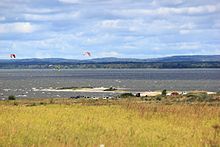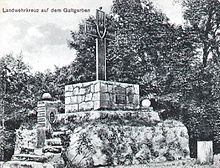Galt sheaves
| Galt sheaves | ||
|---|---|---|
|
Winter on the Galtgarben |
||
| height | 111 m | |
| location | Russia | |
| Coordinates | 54 ° 48 ′ 0 ″ N , 20 ° 15 ′ 0 ″ E | |
|
|
||
| rock | Glauconite | |
The Galt sheaves ( Russian Гальтгарбен ) is 111 m, the highest point of the Alkgebirges in Samland and is in the present Zelenogradsky District . In winter it has been used for skiing since the late 1920s .
history

Initially with the citizens of Königsberg, the students of the Albertus University in Königsberg celebrated commemorations on the Galtgarben for the Wars of Liberation , in 1817 for the Battle of the Nations near Leipzig and from June 18, 1818 for the Battle of Belle Alliance . The Königsberg student body celebrated the summer solstice festivals there until 1939 and later the palae festival .
In honor of the victorious East Prussian Landwehr , the Landwehr Cross was erected on the summit. The war council Johann Georg Scheffner initiated it. For a long time the remains of a Prussian refugee castle could be seen. With the start of skitouristischen use in the late 1920s was East Prussia ski jump built.
In 1910 the city and district of Königsberg acquired the Galtgarben.
Literary
In the demagogue persecution , the Galtgarbenfest on June 18, 1822 resulted in the persecution of Königsberg students. During that celebration the Galtgarbenlied was sung for the first time:
- Now so be the covenant!
- Holy this hour!
- And the starlit night
- Light up our covenant!
- Our covenant is not divided by death,
- No skill and no need
- Should disturb our friendship!
- One day we'll see each other again
- And stand more firmly
- And renew our covenant.
The last three lines of the song were quoted on student funerals . After 1918 they were only part of the Corps Masovia Custom; they have always preceded his list of members. In the songbook of the Albertina has Louis Clerc get the song to posterity.
In her historical novel Das Taubenhaus , Erminia von Olfers-Batocki reports on the Galtgarben Festival in 1832.
Bismarck Tower
In 1898 the Pan-German Association initiated the construction of the tower. Richard Jepsen Dethlefsen won the architectural competition . The tower was inaugurated on September 23, 1906 and from 1908 looked after by the Fischhausen district . On the occasion of the 10th anniversary of Bismarck's death, the Königsberg student body visited the tower on July 23, 1908. In the summer of 1914, shortly before the start of the First World War, a festival hall with stone pillars and stone benches was created in front of the tower entrance on the south side. The stairway to the tower was used as a speaker's platform. At the beginning of the Battle of East Prussia in January 1945, the last German troop unit blew itself up in the Bismarck Tower .
literature
- Karl Emil Gebauer : Customer of the Samland or history and topographical-statistical picture of the East Prussian landscape Samland . Königsberg 1844, pp. 93-94. .
Web links
Individual evidence
- ^ Karl Herbert Kühn: Students in Königsbergs Gassen. From brisk lads, tapeless “camels” and high-spirited pranks . Ostpreußenblatt, June 2, 1956, p. 10.
- ^ Siegfried Schindelmeiser: The Albertina and its students 1544 to WS 1850/51 , vol. 1. Munich 2010, ISBN 978-3-00-028704-6
- ^ Robert Albinus: Königsberg Lexicon . Würzburg 2002, p. 297 (city area)
- ^ Eduard Loch : 1818–1830 Kränzchen, Landsmannschaften Corps , in: Corps Masovia . Munich 2005, ISBN 3-00-016108-2 , p. 37 ff.
- ^ Ludwig Clericus: song book of the Albertina , Königsberg 1850; newly published by Eduard Loch as an unchanged reprint with extensive commentary, Königsberg 1934.
- ^ A b Hans Lippold in a letter to Ludwig Denecke dated December 12, 1967.
- ↑ Jürgen Herrlein , Amella Mai (ed.): Directory of all members of the Corps Masovia 1823 to 2005 . Potsdam 2006.
- ^ Bismarck coat of arms
- ↑ Tower construction with an interruption of several years. The Bismarck Tower in Königsberg (bismarcktuerme.de)



